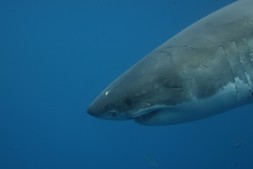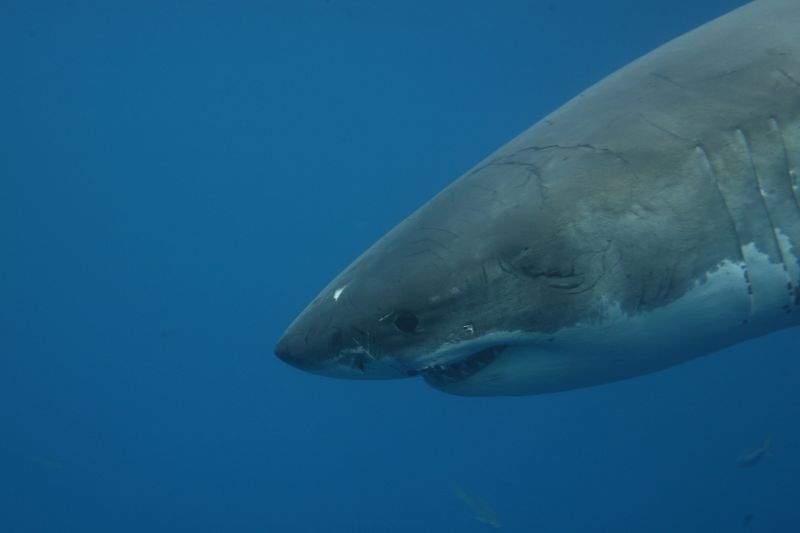Yet sharks get a bad rap. My colleague at the California Academy of Sciences, Dr. John McCosker points out that in the last one hundred years, there have been round 100 white shark attacks in our State waters, with a 10% fatality. The odds of getting killed (if you even enter the water) are greater by simply crossing the street.
How many people actually ever get to see a white shark?
Statistics pale when watching a white shark swim. You are left with the feeling that these sharks belong and we are the interlopers. Unless we reconsider our views on sharks, white sharks could easily go extinct in our lifetimes. But tourists like these might hold the hope. Click, click, the shutters fire as sharks swim past an arm’s reach. Click click fire the synapses as the mind wonders at the size and power of this amazingly adapted beast.
Risks
Interacting with wildlife, especially top predators can be thrilling, but can it also be dangerous.
Wildlife tourism has been long established in the terrestrial environment, but not without problems. Animals and tourists have been killed through negligence and greed. Eventually, guidelines have been established in many regions to protect both the tourists and the wildlife such as tigers and elephants from harm. Many have strict rules like the tours lead through SEEtheWILD. Profits raised through the tourism are directed towards enforcement or conservation but just as important, local jobs are created. Some of these jobs go to the very people who once harvested or poached the animals after protective laws were established. In Baja, Grey Whale Expeditions lead by the American Cetacean Society or events lead by local naturalists of the Ocean Conservation Society allow people an enjoyable first hand experience and provides a valuable economic influx to areas without other options outside of fishing.
Last year I accompanied a sea turtle operation lead through SEE Turtles tagging and tracking sea turtles in Baja. The tourists benefit from hands on experience and learn about the ecology of the animals.
The guides benefit by employment. The turtle populations benefit by more eyes and hearts looking out for their population. Scientists benefit through more data provided by the citizen scientists.
More Valuable Alive the Dead
Like the terrestrial analogue, shark watching operations have experienced a few glitches along the way. These include an over saturation of operations in South Africa leading to overuse of chum and feed impacting the local ecology, altering the shark’s behavior, impacts of sharks with cages and boats and allegations of increased shark attacks. Some non-cage operations in the Bahamas have lead to the accidental death of photographers by Tiger sharks. This has lead to serious restrictions/elimination of chumming and shark/object interactions. However, through government and self regulation my experience at the Farallones and Guadalupe Island is that operators are cleaning up their acts and working for shark conservation. Increasingly via first- hand experience people are observing the beauty and power of sharks, and understanding their importance through shark and shark cage diving. Today, white shark watching occurs off the Farallon Islands under permit by the Gulf of the Farallones National Marine Sanctuary requiring trained naturalists and using strict best watching practices. Many countries like Palau and the Bahamas are banning not only shark finning, but all shark fishing and are benefiting form shark tourism. Sharks are worth more alive than dead. A recent study on the economics of shark tourism suggests one reef shark may bring up to two million dollars in its lifetime through tourism.
On my recent trip to Guadalupe Island, the crew was entirely Mexican and their families helped with activities like provisioning and the vessel preparation. We also helped a local shark scientist Mauricio Hoyos who is engaged in research on the island, and the cage operators contribute to his non profit Tiburon Blanco. Our international team of divers were as amazed by the beauty of the sharks as they were incredulous of the travesty sharks are experiencing worldwide. Each walked away with increased respect both for the majesty of the shark and also for the need to protect them. In our home waters, white sharks are returning to the Sanctuary after migrating thousands of miles and tourists are starting to head west to visit them. We call it Sharktober and all month Sea Stewards and partners will be celebrating sharks and all wildlife. More on learning about and celebrating the shark can be found at Sea Stewards.
 The shark slides effortlessly upwards, the gunmetal back blending imperceptibly from the backdrop of the deep blue sea. It isn’t until the animal turns sideways, revealing the broad fin and the great white grin that I realize a white shark is upon me.
The shark slides effortlessly upwards, the gunmetal back blending imperceptibly from the backdrop of the deep blue sea. It isn’t until the animal turns sideways, revealing the broad fin and the great white grin that I realize a white shark is upon me.